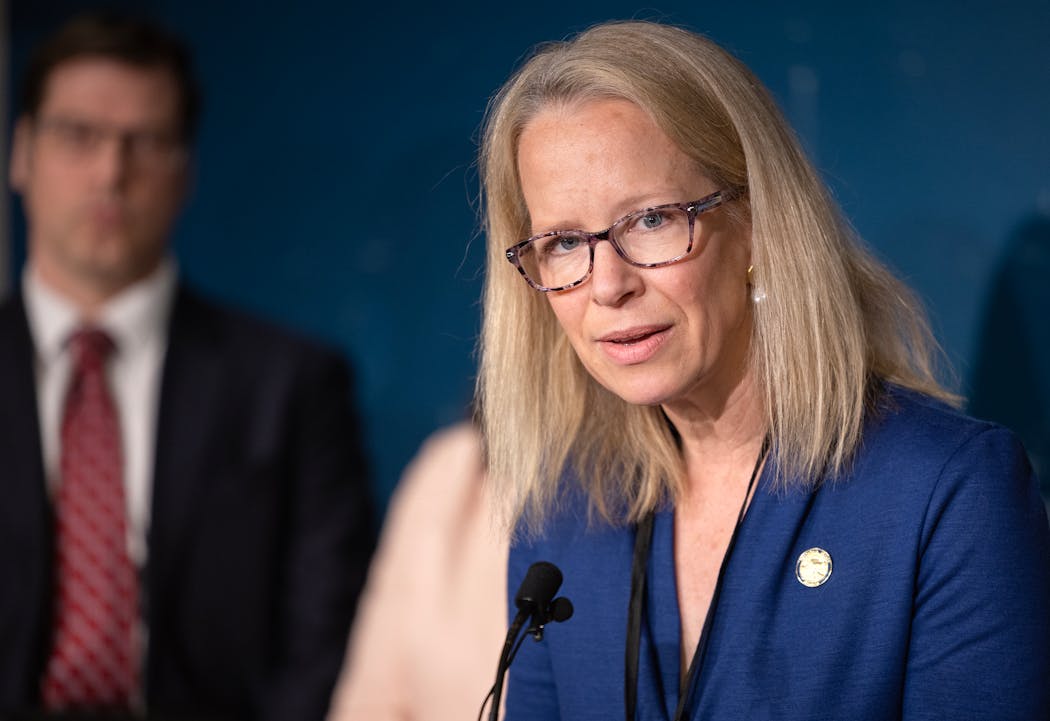School buildings across Minnesota might soon have to stock medication to reverse an opioid overdose as the state grapples with a spike in deaths, including among children, tied to the synthetic opioid fentanyl.
A proposal tucked into state House and Senate budget bills would require schools to have two doses of naloxone, the generic version of Narcan, which can stop overdoses in people with opioids in their system. The medication is safe to use on people who aren't overdosing.
"It doesn't look like much," said U.S. Rep. Dean Phillips, holding up a two-inch plastic nasal spray version of the drug at a state Capitol news conference on Thursday. "It's $25 per dose; a two-pack is $50."
Under the proposal, the state would cover the cost of the medicine for school districts, and the Minnesota Department of Health would create a training video on how to administer naloxone. Phillips is sponsoring a proposal in Congress to allow states to get federal funding to help cover those costs if they require schools to carry naloxone.
Opioid-involved overdose deaths killed nearly 1,000 Minnesotans in 2021, a 44% increase over 2020. Most overdose deaths were tied to fentanyl, which is getting into the hands of more children and teenagers through counterfeit pills.
"They start with a young person in their prime who had a sports-related injury or a relatively minor surgery and were prescribed opioids for the pain," Phillips said. "What starts with pain control quickly evolves, sometimes into addiction. In satisfying cravings, fentanyl and heroin are often then replaced by prescription opioids."
Roughly 30 of more than 330 school districts in Minnesota have naloxone on hand in the case of an overdose, said Colleen Ronnei, executive director of the opioid addiction awareness nonprofit Change the Outcome.
She started the organization in 2017, one year after her son Luke died of an accidental heroin overdose. She's been pushing legislators for years to require schools to have naloxone at the ready.
"A common misperception among youth is that pills are a safer option than trying substances. They don't know the high risk of taking a pill that they don't know specifically where it came from," she said. "They don't know that trying a pill might be the most dangerous thing they could possibly do."
Phillips said the Bloomington school district has saved two lives since it started stocking naloxone. But some school officials have raised concerns about training, who can administer the drug and the burden of covering the costs.
"The devil's always in the details with legislation," said state Sen. Kelly Morrison, DFL-Deephaven, a physician who is sponsoring the Minnesota bill to require schools to have naloxone on hand and has worked with groups to address concerns.
"Our schools are our community gathering places," she added. "We want to protect our kids, but there are a lot of events that also happen on school grounds. We want to make sure that it's available."
Arizona judge rejects GOP wording for voters' abortion ballot initiative pamphlet
FBI says Trump was indeed struck by bullet during assassination attempt



![The exterior of the Minnesota State Capitol Tuesday, May 7, 2013 ] GLEN STUBBE * gstubbe@startribune.com EDS, for any file use ORG XMIT: MIN13](https://arc.stimg.co/startribunemedia/KKSNMLOHCMHLG5ID3YDXXM4K4A.jpg?w=600&h=600&auto=format%2Ccompress&cs=tinysrgb)
